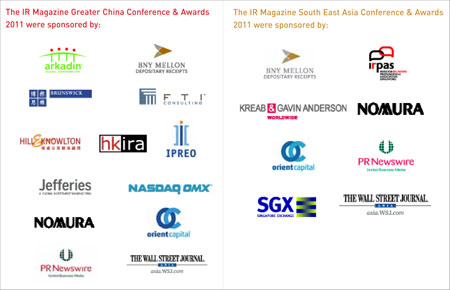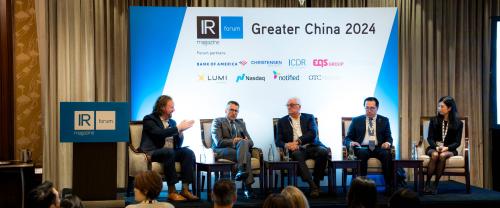IR magazine's conferences in Hong Kong and Singapore saw fiery debate and a passionate defense of the IR profession
Before the lunchtime awards ceremonies in Hong Kong and Singapore, IR magazine hosted two morning conferences where the brightest and best in the industry discussed best practice around six panel-led discussions on various topics, different at each location.
Most of the discussions, moderated by Neil Stewart, IR magazine's editor-at-large, passed by without ire or incident – with two notable exceptions.
One session in each location raised the collective pulse of the room, pushing the air-conditioning into overdrive and even prompting a passionate defense of the profession from a prominent IR professional.
At the Conrad Hong Kong, the stage had been set for the annual IR love-in. Senior IROs like Elizabeth Sun of TSMC and Peter Caveny of Galaxy Entertainment discussed topics such as shareholder targeting, not taking meetings with hedge funds and communicating corporate governance.
Buy and sell side criticize IR
Five sessions passed by with a near silent floor in no apparent rush to question the speakers’ pedigree. Then, in the final session before lunch, it was the investment community’s turn to have a say – or, more accurately, to strike back.
Whether the attack was motivated by collective despair with the level of company disclosure in Asia or simply hungry stomachs anticipating lunch, the panel of two hedge fund managers and two sell-side representatives, one each from Nomura and Jefferies, handed down an indictment of the IR profession right in front of the best practitioners in the business.
Eric Chow, senior fund manager at Value Partners Group, kicked off the critique by turning the typical criticisms of hedge funds – like short-termism – back on the IR professionals.
The incentives for IR practitioners are all wrong, he argued. IROs are encouraged to push up the share price of the company, in part by their own compensation packages, and thus they themselves become too distracted by short-term movements in the market.
In essence, Chow said, the IR community doesn’t understand its own objective to lower the cost of capital for the company to a sustainable level.
Call for better disclosure
Weighing in from the sell side, Robert Lea of Jefferies criticized Asian firms for a lack of full, fair and simultaneous disclosure, singling out Taiwan for special reproach.
The press plays a major role in the predominantly retail market, Lea said, so management often relies on the media to disseminate information.
Other examples of selective disclosure include updating guidance at investor conferences without following up with a wider release, and making disclosures to the stock market without notifying other stakeholders.
All this means investors and analysts who cover these stocks must constantly monitor the newspapers, the news channels and the stock market website, not to mention attend every single investor conference for fear of being left out.
That is a far cry from Lea’s previous role in London, he said, where firms would email this information directly to him.
All this proved too much for the hitherto placid audience. Hands went up, microphones were distributed around the room and all thoughts of lunch were put on hold.
TSMC mounts defense
The most fervent defense of the IR trade came from Sun, sitting in the second row, in spitting distance of the stage.
No doubt spurred on by the criticism of the semiconductor industry in her native Taiwan, she eschewed the traditional question and answer format in favor of a debate-style rebuttal.
Meetings with hedge funds, for instance, are not a question of like or dislike, she pointed out. Rather, they are about resource allocation.
On the topic of meetings with management, she said the CEO’s and CFO’s time is in short supply. What’s more, second-tier business heads do not have the necessary training to talk directly with the investment community without IR in attendance for risk of giving away the company secrets.
To round off her response to the panoply of investor criticisms, Sun pointed out that companies don’t like to go on the road with brokers that have a sell rating on the stock because it offsets the effectiveness of the IR pitch. Job done.
Not quite. Far from shrinking from confrontation, the reply from the stage was unapologetic, bordering on controversial. IR regularly gets in the way, said Chow, which is why investors are increasingly circumventing the IR team and going straight to the company.
In a similar vein, Ivan Lee of Nomura complained about getting bored of speaking to IR where the same message is regurgitated six months later. Did anyone mention lunch?
Singapore inquisition
Over in Singapore, by contrast, it was IR’s turn to ask the hard questions. After a genial first half-hour, involving Harold Woo of CapitaLand and Matt Hardwick of Cisco discussing the closer involvement of IROs in corporate strategy, the second panel pitched the appropriately named Cameron Tough, head of investor relations at Indonesian company Adaro, against two representatives of BNY Mellon Depositary Receipts.
Adaro doesn’t currently have a depositary receipt (DR) program, so Tough’s mandate as the IR community’s advocate-in-chief was to quiz the panelists on the justification for DRs.
He kicked off his Singapore inquisition by demanding to know the benefits of having a DR. It lowers the cost of capital and expands the shareholder base, replied Kammy Yuen, vice president of BNY Mellon Depositary Receipts, who is based in Hong Kong.
On the US side, there are more than 3,500 institutions investing in DRs, which manage about $750 bn of capital, she pointed out. And these days there are DRs in places like Hong Kong and India, as well as the US.
Not quite satisfied, Tough wanted to know which investors he is missing out on by not having a DR. ‘Are there sophisticated long-term investors in the US that can’t invest in companies that don’t have a DR?’ he wondered aloud.
Indeed there are, confirmed Yuen. Typically, they are tier two and tier three investors in cities like Chicago and St Louis.
DR benefits?
Again, Tough pushed for more meaningful benefits, demanding to know exactly how having a DR program lowers the cost of capital. ‘No one is saying, I can’t invest because you don’t have a DR,’ he pointed out.
Holding her nerve, Yuen cited research from an Oxford University affiliate that found that a tier one DR increased liquidity by between 20 percent and 30 percent, and a separate study by the Australian Stock Exchange, which found that DRs also increase domestic liquidity. More liquidity generally lowers the cost of capital, Yuen added.
How about the risks, Tough pressed. Does having an American DR (ADR) expose an overseas company like Adaro to litigious US investors, just like the Japanese company Olympus recently found?
The legal exposure is the same, replied Yuen, before giving the example of a Singaporean company without an ADR that was sued in the US after its CEO made a misleading statement.
‘Hearing you say there is no risk worries me,’ said Tough. In Singapore, it was the coffee break that came to the rescue.
Read about IR magazine's awards events in Hong Kong and Singapore, which took place after the conferences.










